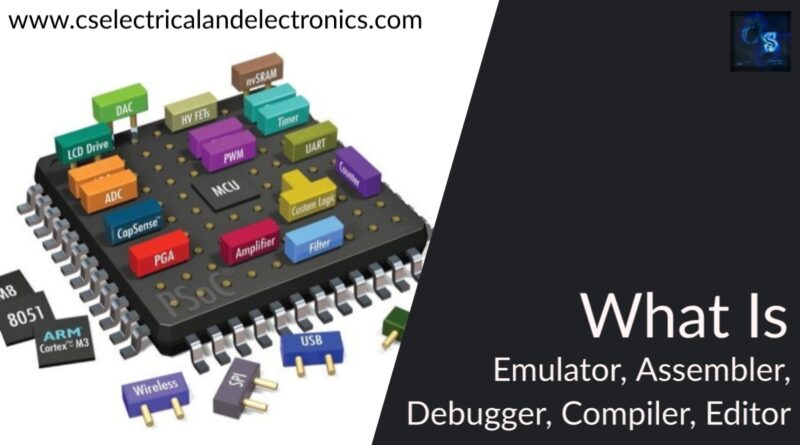What Is Emulator, Debugger, Assembler, Compiler In Embedded Tools
Hello guys, welcome back to my blog. In this article, I will discuss what is emulator, debugger, assembler, compiler, editor in embedded software development tools, and what is the use for each tool.
If you have any electrical, electronics, and computer science doubts, then ask questions. You can also catch me on Instagram – CS Electrical & Electronics And Chetan Shidling.
Also, read:
- Difference Between Dual-core And Quad-core Processors
- What is PyroSwitch In Electric Vehicle, Working, Purpose, Advantages
- Top 12 Fuzzy Logic Projects For Engineers And MTech Students
What Is Emulator, Debugger, Assembler, Compiler, Editor
The present world is changing rapidly with lots of tools. And if you are an engineer working in the embedded field then you have come across the words such as emulator, debugger, assembler, compiler, and editor right? Do you know what is the actual functions of these software development tools? Well, here in this article you will share the clear purpose of it.
All types of Embedded Systems require software to run them for executing specific functions. The microcontroller includes the software for managing all the processes. For the development of software of the embedded system, there are various tools that possess a compiler, emulator, editor, debugger, and assembler. Let’s examine these embedded system software development tools step by step.
Embedded Software Development Tools:
- Emulator
- Debugger
- Assembler
- Compiler
- Editor
Editor
A text editor is the foremost tool you require to begin building an embedded system. It is utilized to document source code in programming languages C and C++ and save this code as a text file. A suitable example of a text editor is Geany. This is a short and light environment that utilizes the GTK+ toolkit. Geany supports C, Java, PHP, Python, Perl, Pascal, and other kinds of files
. The incredibly first tool in the development of software for an embedded system is a text editor. You require to write source code. In Embedded System Development Tools, Editor is utilized to write code for embedded systems applications. It is the editor where one can write that code. The code is written in the programming language either C++ or C. There is a common ASCII text editor that is utilized to write source code and you keep your file as an ASCII text file.
Debugger
This is a vital tool for testing. It goes via the code and eliminates bugs and errors, advising places where they occur. Specifically, debuggers identify the lines where problems are found, so programmers can address them fast. A good debugger device is IDA Pro which operates on Linux, Windows, and Mac OS X operating systems. It includes both free and commercial versions and is positively famous among developers. The name debugger speaks for itself. This tool is utilized for debugging your code.
The debugger is really a tester and is utilized to test whether your code includes an error or not. The debugger has a comprehensive look at the code and tests if there are any mistakes or bugs. It tests various types of errors like any error in your syntax or if there is any runtime error and it tells where the error is really taking place. The place where the error happens is emphasized by the debugger so that you can effortlessly remove your error by accomplishing some changes. So, you get to know how meaningful a debugger in the evolution of software is in embedded systems.
Assembler
This code now describes the machine’s instruction code. One can tell that the goal of the compiler is the transformation of a high-level programming language into a low-level language. The role of this tool is to convert a human-written code into a machine language. In comparison with a compiler, which can do so instantly, an assembler originally transforms source code into object code, and then into a machine language. GNU Assembler (GAS) is widely utilized for Linux operating systems and can be seen in the Macintosh tools package.
Assembler is the tool in your embedded system software development. Once you are accomplished with your source code, you require to translate that code into the instructions on the base of which, the microcontroller will work. The set of instructions in the microcontroller is named ‘Op Codes’. Now, you might be considering what OpCodes are. These bits are decoded and then conducted. Most of the moment, the OpCodes are not documented in bits but in hexadecimal numbers. And one hexadecimal number represents 4 bits. Two hexadecimal number will convey 8 bits which mean 1 byte. OpCodes are even bits (0 and 1) that are present in a series. The compiler is utilized for translating the source code into another code called ‘hex code’.
Compiler
Source code is documented in a high-level programming language. A compiler is a tool for converting the code into a low-level machine language program— the one that a machine can comprehend or understand. Keil C51 is a famous compiler that makes apps for 8051 microcontrollers and transforms source code written in the C language.
Emulator / Stimulator
An emulator is a replica of the target system with similar functionality and components. This tool is required to simulate software performance and to notice how the code will perform in the real-time environment. Utilizing emulators, programmers can modify values in charge to achieve the ideal performance of the code. Once the code is thoroughly checked, it can be embedded in the device. Among all other tools utilized for the development of software for embedded systems, there is another tool stimulator.
The simulator allows you to know how the code that you made really works in reality. You might be capable to see the interaction of sensors by changing the input entries from sensors. You may examine what type of function various components function and what is the effect, made by changing input values.
This was about “”. I hope this article may help you all a lot. Thank you for reading.
Also, read:
- 100 + Electrical Engineering Projects For Students, Engineers
- 1000+ Electronics Projects For Engineers, Diploma, MTech Students
- 1000+ MATLAB Simulink Projects For MTech, Engineering Students
- 500+ Embedded System Projects For Engineer, Diploma, MTech, PhD
- 500+ Projects For Diploma Electrical, Electronics Student, Diploma Project
- 8051 Microcontroller Timers, TCON Register, TMOD Register
- Advancements In 3D Printing Technology And It’s Future
- Advancements In Power Electronics For Energy Efficiency
Author Profile
- Chetu
- Interest's ~ Engineering | Entrepreneurship | Politics | History | Travelling | Content Writing | Technology | Cooking
Latest entries
 All PostsApril 29, 2024Top 11 Free Courses On Battery For Engineers With Documents
All PostsApril 29, 2024Top 11 Free Courses On Battery For Engineers With Documents All PostsApril 19, 2024What Is Vector CANoe Tool, Why It Is Used In The Automotive Industry
All PostsApril 19, 2024What Is Vector CANoe Tool, Why It Is Used In The Automotive Industry All PostsApril 13, 2024What Is TCM, Transmission Control Module, Working, Purpose,
All PostsApril 13, 2024What Is TCM, Transmission Control Module, Working, Purpose, All PostsApril 12, 2024Top 100 HiL hardware in loop Interview Questions With Answers For Engineers
All PostsApril 12, 2024Top 100 HiL hardware in loop Interview Questions With Answers For Engineers








